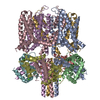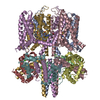+ データを開く
データを開く
- 基本情報
基本情報
| 登録情報 |  | |||||||||
|---|---|---|---|---|---|---|---|---|---|---|
| タイトル | Structure of Xenopus KCNQ1-CaM | |||||||||
 マップデータ マップデータ | ||||||||||
 試料 試料 |
| |||||||||
 キーワード キーワード | ion channel / TRANSPORT PROTEIN | |||||||||
| 機能・相同性 |  機能・相同性情報 機能・相同性情報regulation of gastric acid secretion / membrane repolarization / delayed rectifier potassium channel activity / outward rectifier potassium channel activity / CaM pathway / Cam-PDE 1 activation / intestinal absorption / Sodium/Calcium exchangers / Calmodulin induced events / Reduction of cytosolic Ca++ levels ...regulation of gastric acid secretion / membrane repolarization / delayed rectifier potassium channel activity / outward rectifier potassium channel activity / CaM pathway / Cam-PDE 1 activation / intestinal absorption / Sodium/Calcium exchangers / Calmodulin induced events / Reduction of cytosolic Ca++ levels / Activation of Ca-permeable Kainate Receptor / CREB1 phosphorylation through the activation of CaMKII/CaMKK/CaMKIV cascasde / Loss of phosphorylation of MECP2 at T308 / CREB1 phosphorylation through the activation of Adenylate Cyclase / CaMK IV-mediated phosphorylation of CREB / PKA activation / negative regulation of high voltage-gated calcium channel activity / Glycogen breakdown (glycogenolysis) / CLEC7A (Dectin-1) induces NFAT activation / Activation of RAC1 downstream of NMDARs / negative regulation of ryanodine-sensitive calcium-release channel activity / organelle localization by membrane tethering / mitochondrion-endoplasmic reticulum membrane tethering / autophagosome membrane docking / negative regulation of calcium ion export across plasma membrane / regulation of cardiac muscle cell action potential / presynaptic endocytosis / renal absorption / Synthesis of IP3 and IP4 in the cytosol / regulation of cell communication by electrical coupling involved in cardiac conduction / Phase 0 - rapid depolarisation / calcineurin-mediated signaling / Negative regulation of NMDA receptor-mediated neuronal transmission / Unblocking of NMDA receptors, glutamate binding and activation / inner ear development / RHO GTPases activate PAKs / Uptake and function of anthrax toxins / Ion transport by P-type ATPases / regulation of ryanodine-sensitive calcium-release channel activity / Long-term potentiation / protein phosphatase activator activity / Calcineurin activates NFAT / Regulation of MECP2 expression and activity / DARPP-32 events / monoatomic ion channel complex / Smooth Muscle Contraction / voltage-gated potassium channel activity / detection of calcium ion / regulation of cardiac muscle contraction / catalytic complex / RHO GTPases activate IQGAPs / regulation of cardiac muscle contraction by regulation of the release of sequestered calcium ion / cellular response to interferon-beta / calcium channel inhibitor activity / Activation of AMPK downstream of NMDARs / Protein methylation / presynaptic cytosol / regulation of release of sequestered calcium ion into cytosol by sarcoplasmic reticulum / Ion homeostasis / eNOS activation / titin binding / Tetrahydrobiopterin (BH4) synthesis, recycling, salvage and regulation / sperm midpiece / regulation of calcium-mediated signaling / phosphatidylinositol-4,5-bisphosphate binding / voltage-gated potassium channel complex / potassium ion transmembrane transport / calcium channel complex / FCERI mediated Ca+2 mobilization / substantia nigra development / regulation of heart rate / Ras activation upon Ca2+ influx through NMDA receptor / FCGR3A-mediated IL10 synthesis / Antigen activates B Cell Receptor (BCR) leading to generation of second messengers / cytoplasmic vesicle membrane / calyx of Held / adenylate cyclase activator activity / sarcomere / VEGFR2 mediated cell proliferation / protein serine/threonine kinase activator activity / regulation of cytokinesis / VEGFR2 mediated vascular permeability / spindle microtubule / positive regulation of receptor signaling pathway via JAK-STAT / Translocation of SLC2A4 (GLUT4) to the plasma membrane / calcium channel regulator activity / RAF activation / Transcriptional activation of mitochondrial biogenesis / response to calcium ion / cellular response to type II interferon / Stimuli-sensing channels / G2/M transition of mitotic cell cycle / long-term synaptic potentiation / spindle pole / RAS processing / Signaling by RAF1 mutants / calcium-dependent protein binding / Signaling by moderate kinase activity BRAF mutants / Paradoxical activation of RAF signaling by kinase inactive BRAF / Signaling downstream of RAS mutants 類似検索 - 分子機能 | |||||||||
| 生物種 |  Homo sapiens (ヒト) Homo sapiens (ヒト) | |||||||||
| 手法 | 単粒子再構成法 / クライオ電子顕微鏡法 / 解像度: 3.84 Å | |||||||||
 データ登録者 データ登録者 | Willegems K / Kyriakis E | |||||||||
| 資金援助 |  カナダ, 1件 カナダ, 1件
| |||||||||
 引用 引用 |  ジャーナル: Nat Commun / 年: 2022 ジャーナル: Nat Commun / 年: 2022タイトル: Structural and electrophysiological basis for the modulation of KCNQ1 channel currents by ML277. 著者: Katrien Willegems / Jodene Eldstrom / Efthimios Kyriakis / Fariba Ataei / Harutyun Sahakyan / Ying Dou / Sophia Russo / Filip Van Petegem / David Fedida /   要旨: The KCNQ1 ion channel plays critical physiological roles in electrical excitability and K recycling in organs including the heart, brain, and gut. Loss of function is relatively common and can cause ...The KCNQ1 ion channel plays critical physiological roles in electrical excitability and K recycling in organs including the heart, brain, and gut. Loss of function is relatively common and can cause sudden arrhythmic death, sudden infant death, epilepsy and deafness. Here, we report cryogenic electron microscopic (cryo-EM) structures of Xenopus KCNQ1 bound to Ca/Calmodulin, with and without the KCNQ1 channel activator, ML277. A single binding site for ML277 was identified, localized to a pocket lined by the S4-S5 linker, S5 and S6 helices of two separate subunits. Several pocket residues are not conserved in other KCNQ isoforms, explaining specificity. MD simulations and point mutations support this binding location for ML277 in open and closed channels and reveal that prevention of inactivation is an important component of the activator effect. Our work provides direction for therapeutic intervention targeting KCNQ1 loss of function pathologies including long QT interval syndrome and seizures. | |||||||||
| 履歴 |
|
- 構造の表示
構造の表示
| 添付画像 |
|---|
- ダウンロードとリンク
ダウンロードとリンク
-EMDBアーカイブ
| マップデータ |  emd_25816.map.gz emd_25816.map.gz | 162.1 MB |  EMDBマップデータ形式 EMDBマップデータ形式 | |
|---|---|---|---|---|
| ヘッダ (付随情報) |  emd-25816-v30.xml emd-25816-v30.xml emd-25816.xml emd-25816.xml | 17.3 KB 17.3 KB | 表示 表示 |  EMDBヘッダ EMDBヘッダ |
| FSC (解像度算出) |  emd_25816_fsc.xml emd_25816_fsc.xml | 17.4 KB | 表示 |  FSCデータファイル FSCデータファイル |
| 画像 |  emd_25816.png emd_25816.png | 82.1 KB | ||
| Filedesc metadata |  emd-25816.cif.gz emd-25816.cif.gz | 6.6 KB | ||
| アーカイブディレクトリ |  http://ftp.pdbj.org/pub/emdb/structures/EMD-25816 http://ftp.pdbj.org/pub/emdb/structures/EMD-25816 ftp://ftp.pdbj.org/pub/emdb/structures/EMD-25816 ftp://ftp.pdbj.org/pub/emdb/structures/EMD-25816 | HTTPS FTP |
-検証レポート
| 文書・要旨 |  emd_25816_validation.pdf.gz emd_25816_validation.pdf.gz | 508.5 KB | 表示 |  EMDB検証レポート EMDB検証レポート |
|---|---|---|---|---|
| 文書・詳細版 |  emd_25816_full_validation.pdf.gz emd_25816_full_validation.pdf.gz | 508.1 KB | 表示 | |
| XML形式データ |  emd_25816_validation.xml.gz emd_25816_validation.xml.gz | 13.6 KB | 表示 | |
| CIF形式データ |  emd_25816_validation.cif.gz emd_25816_validation.cif.gz | 18.3 KB | 表示 | |
| アーカイブディレクトリ |  https://ftp.pdbj.org/pub/emdb/validation_reports/EMD-25816 https://ftp.pdbj.org/pub/emdb/validation_reports/EMD-25816 ftp://ftp.pdbj.org/pub/emdb/validation_reports/EMD-25816 ftp://ftp.pdbj.org/pub/emdb/validation_reports/EMD-25816 | HTTPS FTP |
-関連構造データ
| 関連構造データ |  7tcpMC  7tciC C: 同じ文献を引用 ( M: このマップから作成された原子モデル |
|---|---|
| 類似構造データ | 類似検索 - 機能・相同性  F&H 検索 F&H 検索 |
- リンク
リンク
| EMDBのページ |  EMDB (EBI/PDBe) / EMDB (EBI/PDBe) /  EMDataResource EMDataResource |
|---|---|
| 「今月の分子」の関連する項目 |
- マップ
マップ
| ファイル |  ダウンロード / ファイル: emd_25816.map.gz / 形式: CCP4 / 大きさ: 209.3 MB / タイプ: IMAGE STORED AS FLOATING POINT NUMBER (4 BYTES) ダウンロード / ファイル: emd_25816.map.gz / 形式: CCP4 / 大きさ: 209.3 MB / タイプ: IMAGE STORED AS FLOATING POINT NUMBER (4 BYTES) | ||||||||||||||||||||||||||||||||||||
|---|---|---|---|---|---|---|---|---|---|---|---|---|---|---|---|---|---|---|---|---|---|---|---|---|---|---|---|---|---|---|---|---|---|---|---|---|---|
| 投影像・断面図 | 画像のコントロール
画像は Spider により作成 | ||||||||||||||||||||||||||||||||||||
| ボクセルのサイズ | X=Y=Z: 0.73 Å | ||||||||||||||||||||||||||||||||||||
| 密度 |
| ||||||||||||||||||||||||||||||||||||
| 対称性 | 空間群: 1 | ||||||||||||||||||||||||||||||||||||
| 詳細 | EMDB XML:
|
-添付データ
- 試料の構成要素
試料の構成要素
-全体 : Potassium voltage-gated channel subfamily KQT member 1 in complex...
| 全体 | 名称: Potassium voltage-gated channel subfamily KQT member 1 in complex with calmodulin |
|---|---|
| 要素 |
|
-超分子 #1: Potassium voltage-gated channel subfamily KQT member 1 in complex...
| 超分子 | 名称: Potassium voltage-gated channel subfamily KQT member 1 in complex with calmodulin タイプ: complex / ID: 1 / 親要素: 0 / 含まれる分子: #1-#2 |
|---|---|
| 由来(天然) | 生物種: |
| 分子量 | 理論値: 317.56 KDa |
-分子 #1: Potassium voltage-gated channel subfamily KQT member 1
| 分子 | 名称: Potassium voltage-gated channel subfamily KQT member 1 タイプ: protein_or_peptide / ID: 1 / コピー数: 4 / 光学異性体: LEVO |
|---|---|
| 由来(天然) | 生物種: |
| 分子量 | 理論値: 62.663398 KDa |
| 組換発現 | 生物種:  Homo sapiens (ヒト) Homo sapiens (ヒト) |
| 配列 | 文字列: MATDPPRPTI NLDPRVSIYS GRRPLLSRTN IQGRVYNFLE RPTGWKCFVY HFTVFLIVLI CLIFSVLSTI QQYNNLATET LFWMEIVLV VFFGAEYVVR LWSAGCRSKY VGVWGRLRFA RKPISVIDLI VVVASVIVLC VGSNGQVFAT SAIRGIRFLQ I LRMLHVDR ...文字列: MATDPPRPTI NLDPRVSIYS GRRPLLSRTN IQGRVYNFLE RPTGWKCFVY HFTVFLIVLI CLIFSVLSTI QQYNNLATET LFWMEIVLV VFFGAEYVVR LWSAGCRSKY VGVWGRLRFA RKPISVIDLI VVVASVIVLC VGSNGQVFAT SAIRGIRFLQ I LRMLHVDR QGGTWRLLGS VVFIHRQELI TTLYIGFLGL IFSSYFVYLA EKDAIDSSGE YQFGSYADAL WWGVVTVTTI GY GDKVPQT WIGKTIASCF SVFAISFFAL PAGILGSGFA LKVQQKQRQK HFNRQIPAAA SLIQTAWRCY AAENPDSATW KIY IRKQSR NHHLMSPSPK PKKSAMVKKK KIRTERDEGS TDKMLNIPHI TYDHVADDRK NDGYSVESYE NTVRKPFGFL DPST GPFIR TSSFTDDLDM EGDTLLTPIT HISELKEHHR AAIKVIRRMQ YFVAKKKFQQ ARKPYDVRDV IEQYSQGHLN LMVRI KELQ RRLDQSLGKP SLFLSVSDKV KDKGINTIGS RLNRVEDKVT QMDHKLNLIT DMLHHLLTNQ QSNS UniProtKB: Potassium voltage-gated channel subfamily KQT member 1 |
-分子 #2: Calmodulin-1
| 分子 | 名称: Calmodulin-1 / タイプ: protein_or_peptide / ID: 2 / コピー数: 4 / 光学異性体: LEVO |
|---|---|
| 由来(天然) | 生物種:  Homo sapiens (ヒト) Homo sapiens (ヒト) |
| 分子量 | 理論値: 16.852545 KDa |
| 組換発現 | 生物種:  Homo sapiens (ヒト) Homo sapiens (ヒト) |
| 配列 | 文字列: MADQLTEEQI AEFKEAFSLF DKDGDGTITT KELGTVMRSL GQNPTEAELQ DMINEVDADG NGTIDFPEFL TMMARKMKDT DSEEEIREA FRVFDKDGNG YISAAELRHV MTNLGEKLTD EEVDEMIREA DIDGDGQVNY EEFVQMMTAK UniProtKB: Calmodulin-1 |
-分子 #3: CALCIUM ION
| 分子 | 名称: CALCIUM ION / タイプ: ligand / ID: 3 / コピー数: 12 / 式: CA |
|---|---|
| 分子量 | 理論値: 40.078 Da |
-実験情報
-構造解析
| 手法 | クライオ電子顕微鏡法 |
|---|---|
 解析 解析 | 単粒子再構成法 |
| 試料の集合状態 | particle |
- 試料調製
試料調製
| 濃度 | 2 mg/mL | |||||||||||||||||||||
|---|---|---|---|---|---|---|---|---|---|---|---|---|---|---|---|---|---|---|---|---|---|---|
| 緩衝液 | pH: 7.2 構成要素:
| |||||||||||||||||||||
| グリッド | モデル: Quantifoil R1.2/1.3 / 材質: COPPER / メッシュ: 400 / 前処理 - タイプ: GLOW DISCHARGE / 前処理 - 時間: 25 sec. | |||||||||||||||||||||
| 凍結 | 凍結剤: ETHANE / チャンバー内湿度: 98 % / チャンバー内温度: 277.15 K / 装置: FEI VITROBOT MARK IV |
- 電子顕微鏡法
電子顕微鏡法
| 顕微鏡 | FEI TITAN KRIOS |
|---|---|
| 撮影 | フィルム・検出器のモデル: FEI FALCON IV (4k x 4k) 検出モード: COUNTING / 撮影したグリッド数: 1 / 実像数: 19997 / 平均電子線量: 50.0 e/Å2 |
| 電子線 | 加速電圧: 300 kV / 電子線源:  FIELD EMISSION GUN FIELD EMISSION GUN |
| 電子光学系 | 照射モード: FLOOD BEAM / 撮影モード: BRIGHT FIELD / 最大 デフォーカス(公称値): 4.9 µm / 最小 デフォーカス(公称値): 0.36 µm |
| 試料ステージ | 試料ホルダーモデル: FEI TITAN KRIOS AUTOGRID HOLDER ホルダー冷却材: NITROGEN |
| 実験機器 |  モデル: Titan Krios / 画像提供: FEI Company |
 ムービー
ムービー コントローラー
コントローラー


























 Z (Sec.)
Z (Sec.) Y (Row.)
Y (Row.) X (Col.)
X (Col.)





















